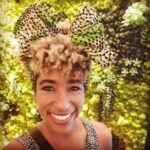
Tracee Ellis Ross on the cover of Elle magazine's State of Black Beauty issue
Djeneba Aduayom / Elle Magazine
Black hair is political.
It is still a radical act for Black people to wear our hair just as it grows out of our heads.
Just as Black people are diverse, Black hair is inclusive of a broad range of colors, textures, density, and porosity. Terms like 3B and 4C are commonly used to describe hair types. While some people still think of hair types as a grading scheme, much like the debate about having “good hair,” we are learning more about how hair types have specific care needs. As we grow deeper in love with ourselves and our hair, Black people are looking for the best products on the market and are committed to supporting Black businesses.
When Tracee Ellis Ross announced the launch of Pattern Beauty, there was a lot of buzz and excitement. A Black woman we love and whose hair has always been an unapologetically overwhelming feature was going to respond to Black hair care needs. Sign us up! Now, however, with her Elle magazine cover, some Black women are wondering if Ross is taking up too much of the Black hair space.
Does Your Hair Do That?
This month, Tracee Ellis Ross is on the cover of Elle magazine’s “State of Black Beauty” issue. For the story, she was interviewed by Kerry Washington, via Zoom, about Black beauty and Black hair. They talked about being in the entertainment business, style expectations, and the importance of representation of Black beauty that stands on its own. Kerry Washington said, “Our beauty is coming not from a denial, or a covering or a hiding, but from a nurturing of who we really are.”
Representation has always been important. In the interview, Ross said, “All of the things that I was taught from the media were like, I was supposed to have easy breezy beautiful hair. Bouncin’ and behavin.’ My hair didn’t blow in the wind! All of these things didn’t match up.”
On the magazine cover, Ellis Ross’ hair is in plaits (or braids) that are upturned, giving her head a chandelier-like look. The hairstyle emphasizes the way many types of Black hair refuse to hang, blow, or bounce. Tighter textures are often gravity-defying and, sometimes, take certain shapes based on the style. There are Black women whose hair would naturally behave the way Ellis Ross’ does on the cover, making the upturned shape. Some people are questioning whether or not her hair does that all on its own. It likely doesn’t–so why fake it?
The Tiering of Black Hair
In truth, Tracee Ellis Ross has one of the more “acceptable” kinds of Black hair. In the false hierarchy of Black hair, curly is queen. Coily is a distant second. Tighter textures are far behind. This, of course, isn’t really about beauty. It is, like all issues of race and colorism, based on proximity to whiteness. This is part of why the presence of a light-skinned Black woman with type 3 hair on the cover of the Elle magazine issue on Black beauty sparks such complex thoughts and feelings. The contention surrounding Ellis Ross’ cover story is rooted in the fact that she is not representative of the most marginalized among us.
Let’s be real. It’s great that a Black woman is on that cover, that Black beauty is a topic Elle decided to explore, and that so many of us are talking about the discomfort the cover has caused. We need this. We need people within our own community to recognize their privilege and think about how they can use it for the greatest good.
There are some opportunities that are better passed on to someone else, and there are some that must be seized in order to expose the inaccessibility of certain platforms for the people who need them most. That’s what was missing from Ross’ interview. She needed to acknowledge that, though she represents a large community, only a small segment looks like her, while many others are discriminated against and considered less beautiful because of it.
We’re all still learning to own, define, and embody the beauty of blackness. We are on a journey toward seeing blackness as beauty in its own right, free of entanglements with or relationships to Eurocentric beauty standards. How, then, is a primary representative of Black beauty and the person chosen to talk about it a Black woman who fits many of the beauty standards we are trying to leave behind?
Pass the Privilege, Share the Space
In her conversation with Washington, Ellis Ross said, “Every courageous act that a marginalized person takes opens up a space for somebody else.” She is taking up space, and it is a big deal that she is on the cover of this magazine focusing on Black beauty and Black hair. It was a missed opportunity, however, to either create space for other experiences or to highlight Ross’ own privilege, thereby bringing a conversation about intersections of identity and varying degrees of discrimination to a broad audience.
We know Ellis Ross is fun and has an offbeat style, but her hairstyle felt like a caricature, and one that was completely unnecessary because there are Black women who have the kind of hair she seemed to be trying to mimic.
It would have been incredible to see Viola Davis on the cover, particularly after the moment in How to Get Away with Murder when Annalise took off her wig. In an interview with Essence, Davis shared that it was her idea to remove the wig because she wouldn’t normally go to bed with a wig on. That scene was a portrayal of Black women’s real experience, no skipping the details for the television audience. It would have been great to see that kind of authenticity, particularly from a dark-skinned woman with type 4 hair, on the cover of a magazine trying to realistically portray Black hair.
The Power of Privilege and Black Girl Magic
In the interview, Kerry Washington said, “The more that we make room for ourselves, we make room for each other. And that, in turn, reverberates out into community.” While she is right, there is a big gap between room for them and room for us.
It’s one thing to be on the cover of a magazine representing Black beauty, and it’s another thing to use that space, that opportunity, and that privilege to remind people that you are not the sole or best representative, but rather the one with sufficient privilege and access to land you there. Sometimes we take the roles we know someone else should have because we know they won’t get access unless we take up space on their behalf and use it to build the relationship, highlight the need, and make the connections to get them there. That is the power of privilege used well.
Ellis Ross said, “I realize that Black girls have been magic forever, but once we got this term, the world was able to see that magic in a way it wasn’t being received before.” Maybe her Black girl magic is easier to see because of the privilege she has, but if she uses them together for a higher good, more people will be able to recognize and respect our magic that goes far beyond the curls, coils, and kinks that crown our heads.














